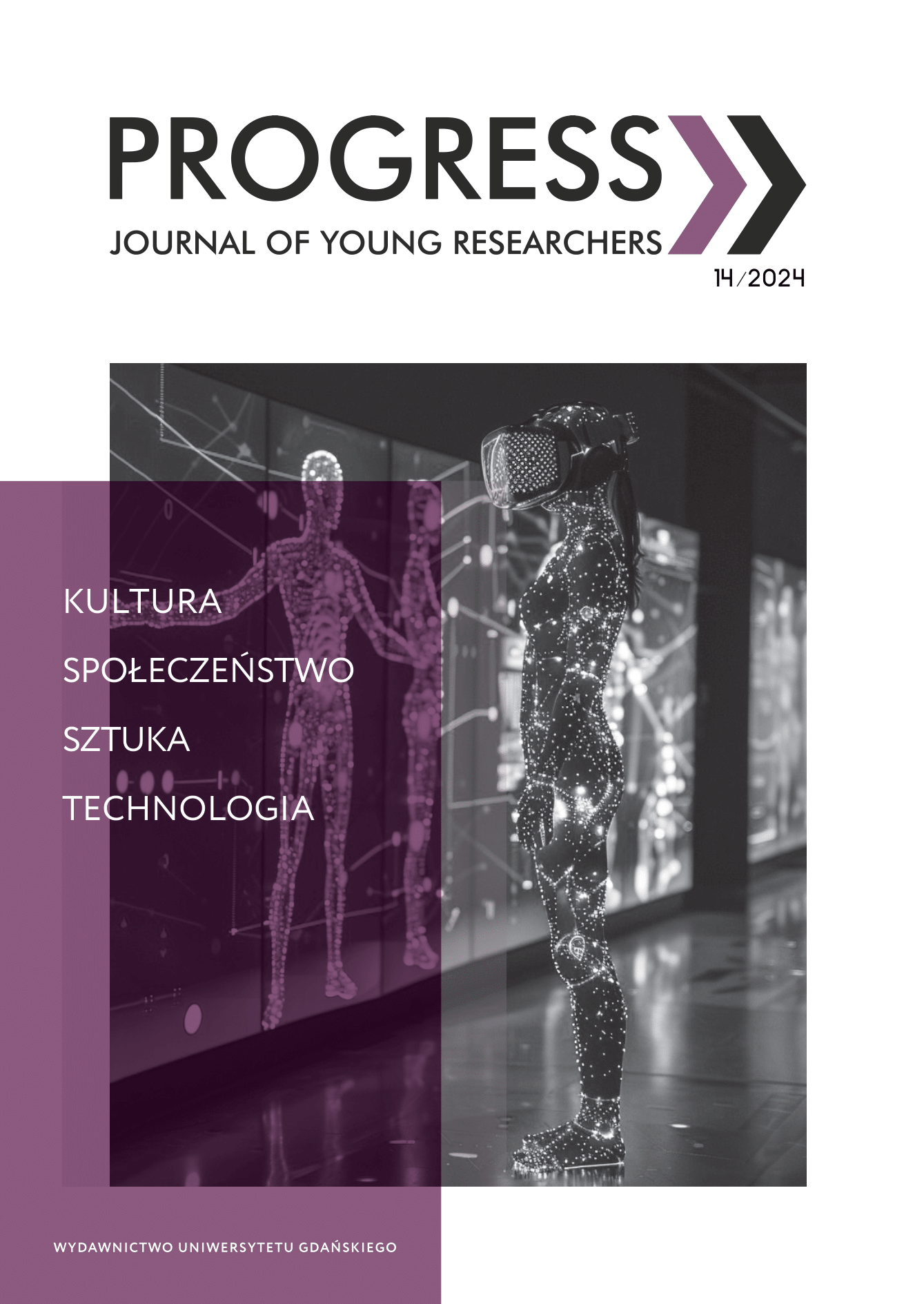Wpływ sztuki nielegalnej na budowanie tożsamości miejskiej
DOI:
https://doi.org/10.26881/prog.2024.14.09Słowa kluczowe:
graffiti, sztuka nielegalna, tożsamość, przestrzeń publiczna, street artAbstrakt
Współczesne graffiti i street art, stanowiące kluczowe elementy miejskiego krajobrazu, odgrywają znaczącą rolę w kształtowaniu tożsamości społecznej i urbanistycznej. W artykule zbadano wpływ tych form artystycznych na percepcję przestrzeni miejskich, podkreślając ich znaczenie dla ewolucji miejskiej tożsamości w kontekście nowej ekonomii opartej na kreatywności. Analiza efemeryczności graffiti oraz street artu pokazuje, jak spotkanie z tymi dziełami w przestrzeni miejskiej może przerywać codzienność i zwiększać świadomość społeczną, co przekłada się na dynamiczne rozpoznawanie i interpretację miejskich krajobrazów.
Przez integrację różnorodnych perspektyw – od historii sztuki po socjologię i filozofię – niniejsze badanie ujawnia złożoność wpływu sztuki ulicznej na życie miejskie oraz na kulturowe aspekty współczesnych społeczeństw. Sztuka uliczna, łącząc różne media, nowe technologie oraz bodźce sensoryczne, tworzy unikalną jedność w wielości, angażując odbiorców na poziomie fizycznym i psychicznym. To zaangażowanie, zarówno w wymiarze fenomenologicznym, jak i w codziennym życiu, podkreśla znaczenie dalszych interdyscyplinarnych badań nad sztuką uliczną jako nieodłączną częścią kultury miejskiej.
Downloads
Bibliografia
Bator I., 2015, Nowe ujęcie nadgraniczności Cieszyna do wykorzystania, w: Sztuka w przestrzeni publicznej. Artystyczne wymiary wytwarzania kapitału społecznego i kulturowego, Bielsko-Biała–Cieszyn.
Birkeland I., 2008, Cultural Sustainability: Industrialism, Placelessness and the Re-animation of Place, „Ethics, Place & Environment: A Journal of Philosophy & Geography”, Vol. 11, No. 3.
Chmielewski J.M., 2001, Teoria urbanistyki w projektowaniu i planowaniu miast, Warszawa.
Dzidzia B., Kiedy sztuka wytwarza kapitał. Zaangażowanie i sztuka w przestrzeni publicznej, w: Sztuka w przestrzeni publicznej. Artystyczne wymiary wytwarzania kapitału społecznego i kulturowego, Bielsko-Biała–Cieszyn.
Druh S., 2005, Wstęp w: Cała A., Miszczak R. (red.), Beaty, Rymy, Życie. Leksykon muzyki hip hop, Poznań.
Frydryczak B., 1998, Okiem przechodnia: ulica jako przestrzeń estetyczna, w: A. Zeidler-Janiszewska,
J.S. Wojciechowski (red.), Formy estetyzacji przestrzeni publicznej, Warszawa.
Frysztacki K., 2005, Między przestrzenią i publicznością miejską, w: B. Jałowiecki (red.), Przemiany miasta: wokół socjologii Aleksandra Wallisa, Warszawa.
Hildebrandt P.M., 2012, Urbane Kunst, w: F. Eckardt (red.), Handbuch Stadtsoziologie, Wiesbaden.
Hoppe I., 2016, Urban Art: Creating the Urban With Art, w: Urban Art: Creating the Urban with Art: Proceedings of the International Conference at Humboldt-Universitat zu Berlin 15–16 July.
Ingarden R., 1970, Studia z Estetyki, tom III, Warszawa.
Israel F., Velasco A., 2014, Prawo, zbrodnia i graffiti Gdzie nie ma wolności, będzie graffiti, w: A. Łukaszewicz (red.), Burząc mury graffiti: korespondencje street-artystów, Szczecin.
Jach A., 2008, Street art jako aktywność społeczna, „Czas Kultury”, nr 1(142).
Leger F., 1970, Funkcje malarstwa, Warszawa.
Louis W., 1938, Urbanism as a way of Life, „The American Journal of Sociology”, t. 44, nr 1.
Markowski T., 2009, Karta przestrzeni publicznej, Warszawa.
Massey D., 2004, Geographies of Responsibility, w: Geografiska Annaler. Series B, Human Geography t. 86, nr 1.
Mitchell W.J.T., 1990, The Violence of Public Art. Do the Right Thing, „Critical Inquiry”, No. 16.
Mouffe C., 2015, Agonistyczne przestrzenie publiczne i polityka demokratyczna, Warszawa.
Norberg-Schulz C., 1980, Genius loci: Towards a Phenomenology of Architecture, New York.
Rudkiewicz M., 2017, Dzika grafika. Pięć dekad ulicznej dywersji wizualnej w Polsce, w: M. Warda (red.), Dzika grafika. Pół wieku ulicznej dywersji wizualnej w Polsce 1967–2017, Warszawa.
Rudkiewicz M., 2013, Dzieła graffiti i street artu, „Nasza Polska”, t. 89, Bydgoszcz.
Rybson P., 2017, Palimsest wolności, w: M. Warda (red.), Dzika grafika. Pół wieku ulicznej dywersji wizualnej w Polsce 1967–2017, Warszawa.
Sikorska P., Sulmicki M., 2015, Czy Warszawa jest otwarta na przestrzenie publiczne? Teoria a praktyka, Stowarzyszenie Zielone Mazowsze Komisja Dialogu Społecznego ds. Transportu przy Biurze Koordynacji Remontów i Inwestycji w Pasie Drogowym Urzędu m. st. Warszawy, Warszawa.
Sławek T., 2010, Miasto. Próba zrozumienia, w: E. Rewers (red.), Miasto w sztuce – sztuka miasta, Kraków.
Taborska H., 2005, Współczesna sztuka publiczna i nie-miejsca Warszawy – z Europą w tle, „Kultura Współczesna”, nr 4.
Tatarkiewicz W., 1960, Historia estetyki, t. 1, Ossolineum, Wrocław–Warszawa–Kraków.
Tuan Y., 2008, Space and place : the perspective of experience, Minneapolis.
Walsch M., 1996, Graffito, New York.
Wręga M., 2005, Od ulicy do galerii. Proces instytucjonalizacji street artu w Polsce, praca magisterska na Akademii Sztuk Pięknych w Łodzi.
Żakowski M., 2006, Street art i indywidualizacja. W stronę tożsamości awangardowej. Miejskie gry uliczne, awangarda i polityka, „Kultura Popularna”, nr 2(16).
Pobrania
Opublikowane
Jak cytować
Numer
Dział
Licencja
Prawa autorskie (c) 2024 Author(s)

Utwór dostępny jest na licencji Creative Commons Uznanie autorstwa 4.0 Międzynarodowe.

 Uniwersyteckie Czasopisma Naukowe
Uniwersyteckie Czasopisma Naukowe




